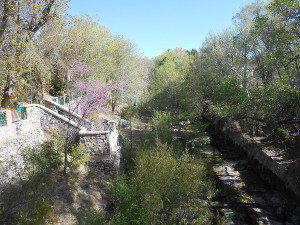We think that New Mexico's chilis are the hottest. Hatch, New Mexico,  Ebullient store
makes the claim that it is the chili capital of the world, with the unmistakable illustration of the pepper appearing even on the badge of the police officers. Approaching the town we could see the great fields of pepper plants, and we were charmed by the statues on Main Street (can you see the chili pepper next to Uncle Sam?). Even a small, dusty town can be endearing, when it shares itself with passersby.
Ebullient store
makes the claim that it is the chili capital of the world, with the unmistakable illustration of the pepper appearing even on the badge of the police officers. Approaching the town we could see the great fields of pepper plants, and we were charmed by the statues on Main Street (can you see the chili pepper next to Uncle Sam?). Even a small, dusty town can be endearing, when it shares itself with passersby.
Whenever we leave the lower elevations and climb into the mountains which in New Mexico seem always to surround us, we remember it is still early in the year. The Organ Mountains walking trail was warm, but the land around the Emory Pass was still snow-covered. It was, of course, beautiful, with just a light dusting on branches and the ground. Apparently Emory Pass  Higher elevations
was named by a nineteenth century soldier, Lieutenant Emory.
Higher elevations
was named by a nineteenth century soldier, Lieutenant Emory.
Throughout the West, and particularly the Southwest, we find traces of soldiers and forts. The stories are usually about the same: a troop of soldiers is called in to guard a settlement or part of a route used by Americans moving West. They will subdue the savage Indians. There are battles.
It is an ugly story, but there can be softening details: when permanent forts are established, the soldiers' families plant gardens, put wallpaper and curtains in houses, create churches and meetings and dance parties, and slowly a town is born. It is not the required way to develop cities, but it surely is a frequent method. For today's tourists, there is  Riverside walls
interest in tracing the remains of foundations, learning from correspondence and records about the life of soldiers and their officers.
Riverside walls
interest in tracing the remains of foundations, learning from correspondence and records about the life of soldiers and their officers.
Sometimes we find mysterious constructions, perhaps parts of buildings or structures where the original idea got lost along the way. Sometimes the money just runs out and the workers go home, leaving piles of rocks and materials. In Silver City, New Mexico, now a town pretty much entirely devoted to tourism, there are lovely stone steps from the shopping street down to the water, and parts of other buildings which probably date from the nineteenth century when this was a major transportation hub. They are still solid, but ignored.
 Big pit
Big pit
The giant earthworks projects were born later, after the creation of mighty mining machines. New Mexico is a good place to see some of the results of the giant mines. The mine in our picture is a copper mine still being worked. Look for the tiny pickup truck on the road along the side of the pit; can you see it?
We have learned in our genealogy work that Elsa had an adventurous relative named Ellen Rowe who married a miner and followed him across the country, even though the rest of her family stayed in Wisconsin. When Ellen and her husband reached Silver City, New Mexico, they ran a boarding house for miners who, like the Rowes, had come from Cornwall. They must have enjoyed hearing familiar accents and eating Cornish food.
 Ebullient store
makes the claim that it is the chili capital of the world, with the unmistakable illustration of the pepper appearing even on the badge of the police officers. Approaching the town we could see the great fields of pepper plants, and we were charmed by the statues on Main Street (can you see the chili pepper next to Uncle Sam?). Even a small, dusty town can be endearing, when it shares itself with passersby.
Ebullient store
makes the claim that it is the chili capital of the world, with the unmistakable illustration of the pepper appearing even on the badge of the police officers. Approaching the town we could see the great fields of pepper plants, and we were charmed by the statues on Main Street (can you see the chili pepper next to Uncle Sam?). Even a small, dusty town can be endearing, when it shares itself with passersby.
 Higher elevations
Higher elevations Riverside walls
Riverside walls Big pit
Big pit